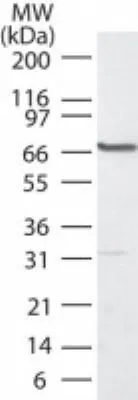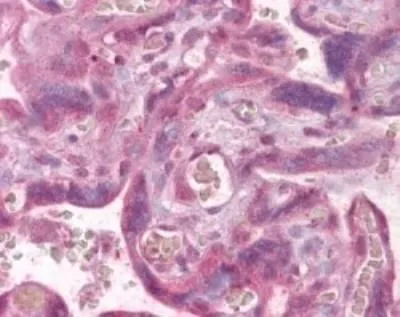
WB analysis of HCT-116 cell lysate using GTX48549 PLK1 antibody. Dilution : 1:2000
PLK1 antibody
GTX48549
ApplicationsWestern Blot, ImmunoHistoChemistry, ImmunoHistoChemistry Paraffin
Product group Antibodies
ReactivityBovine, Canine, C. Elegans, Human, Mouse, Porcine, Primate, Rat, Xenopus, Zebra Fish
TargetPLK1
Overview
- SupplierGeneTex
- Product NamePLK1 antibody
- Delivery Days Customer9
- Application Supplier NoteWB: 1:1000 - 1:2000. *Optimal dilutions/concentrations should be determined by the researcher.Not tested in other applications.
- ApplicationsWestern Blot, ImmunoHistoChemistry, ImmunoHistoChemistry Paraffin
- CertificationResearch Use Only
- ClonalityPolyclonal
- ConjugateUnconjugated
- Gene ID5347
- Target namePLK1
- Target descriptionpolo like kinase 1
- Target synonymscell cycle regulated protein kinase; PLK; PLK-1; polo (Drosophia)-like kinase; serine/threonine-protein kinase 13; serine/threonine-protein kinase PLK1; STPK13
- HostRabbit
- IsotypeIgG
- Protein IDP53350
- Protein NameSerine/threonine-protein kinase PLK1
- Scientific DescriptionSerine/threonine-protein kinase that performs several important functions throughout M phase of the cell cycle, including the regulation of centrosome maturation and spindle assembly, the removal of cohesins from chromosome arms, the inactivation of APC/C inhibitors, and the regulation of mitotic exit and cytokinesis. Required for recovery after DNA damage checkpoint and entry into mitosis. Required for kinetochore localization of BUB1B. Phosphorylates SGOL1. Required for spindle pole localization of isoform 3 of SGOL1 and plays a role in regulating its centriole cohesion function. Phosphorylates BORA, and thereby promotes the degradation of BORA. Contributes to the regulation of AURKA function. Regulates TP53 stability through phosphorylation of TOPORS.
- ReactivityBovine, Canine, C. Elegans, Human, Mouse, Porcine, Primate, Rat, Xenopus, Zebra Fish
- Storage Instruction-20°C or -80°C,2°C to 8°C
- UNSPSC12352203

